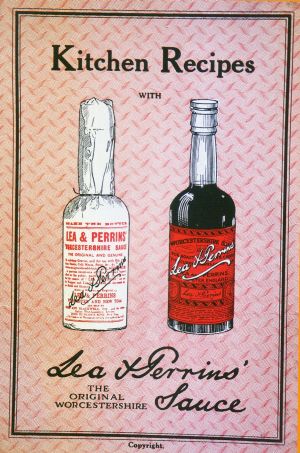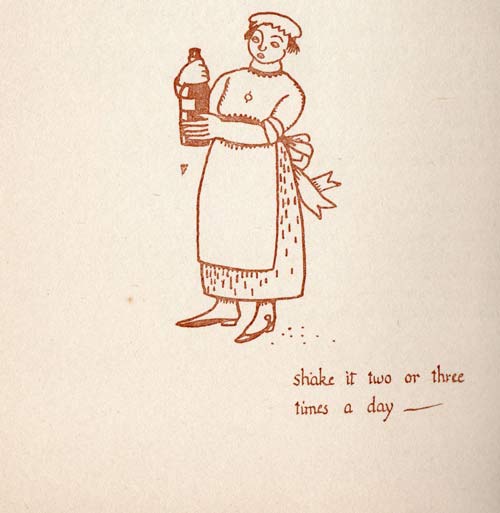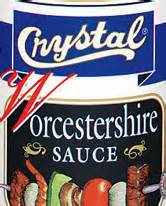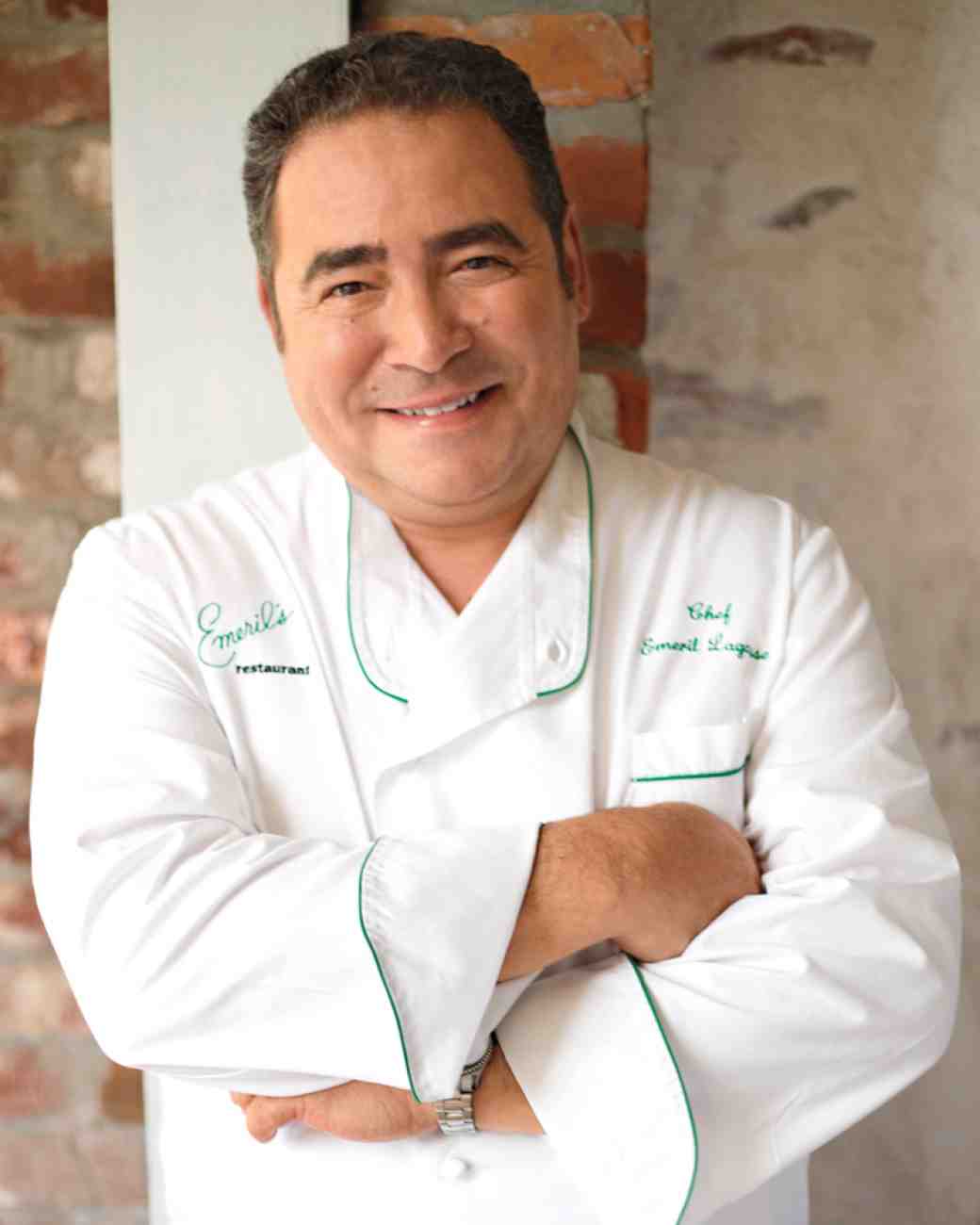Observations & variations on Worcestershire & its permutations, highlighting three recipes.
1. The origin of an iconic ingredient.
At britishfoodinamerica we have never hidden an enduring affection, perhaps even addiction, for Worcestershire sauce. Its creation myth makes it all the more appealing, for the Worcestershire we know is a creature of accident. In 1837, John Lea and William Perrins formulated their first batch of what they would call Worcestershire in the back room of their chemist shop, or drug store, in the English city of Worcester. In its original state the sauce was so harsh they considered it inedible, but in a typically British fit of absentmindedness forgot to throw the barrel away. When one of them happened upon the barrel some time later, its contents had fermented to become the same sauce sold today.

It is not clear when Lea and Perrins first bottled Worcestershire for sale, but sometime before 1840 they had managed trough payoffs to ships’ stewards to stow cases of their sauce on ocean liners for service in their dining rooms. By 1840, they were selling the sauce in New York and the ascent of a global phenomenon had begun.
Worcestershire was the first Thing We Like ever posted at bfia and features in lots of our recipes. It transpires that lots of other people like it too, in some unexpected places. Along with Tabasco, a bottle remains a fixture on each table of the best old line Creole restaurants in New Orleans, and a surprising proportion of Parisian bistros follow suit. Jamie Oliver boils beef in a bath using whole bottles of the sauce and the result is surprising in its soothing subtlety.
Lots of people also have tried, usually with little success, to improve on the original product. Some of their sauces resemble Worcestershire in name alone; others are recognizable riffs on the real thing.
2. A lost formula.
Helen Edden’s Worcester sauce from County Recipes of Old England is extremely good and easy to make--if you can find the ingredients, which is a simple task in the United Kingdom but difficult in the United States. Her recipe uses walnut instead of our mushroom ketchup because walnut ketchup has fallen from favor and become difficult to find. So is this formula from 1929; it has disappeared from view, so do the right thing and engage in some rewarding rescue archeology of your own.
- 20 oz malt vinegar
- 2 Tablespoons anchovy sauce
- 3 Tablespoons mushroom ketchup
- 2 Tablespoons soy sauce
- about ¼ teaspoon cayenne
- 2 minced shallots
- possibly a little good salt (like Maldon)
Just dump the ingredients in a Mason jar with a good seal and shake it three times daily for two weeks, then strain and bottle your Worcester sauce.

Notes:
-George Watkins sells both anchovy sauce and mushroom ketchup; the products are available at British specialty shops like Myers of Keswick in Manhattan and Spencer’s Jolly Posh in Chicago as well as online.
-Nobody seems to sell walnut ketchup anymore and it is difficult for the home cook to replicate because as with pickled walnuts the nuts in question must be picked green, before their shells harden.
-If a whiff of walnut is indispensable to your concept of country Worcestershire, try using juice--seasoned malt vinegar--from a jar of pickled walnuts, also available from Watkins.
-If you cannot find or do not want anchovy essence (but you can; and why wouldn’t you?) mince up a couple of canned anchovies or substitute about a teaspoon of anchovy paste, more or less as you like.
-Miss Edden’s Worcester, or Worcestershire, recipe originally appeared long after Lea & Perrins had first formulated their peerless product. She got her recipes from home cooks, so someone resourceful created this alternative to the commercial formula. While it shares a certain flavor palette, the homebrew diverges from the Lea & Perrins model in crucial respects. Strictly speaking the variations share nothing in common.
-While its proportions are understandably proprietary, the Lea & Perrins label lists its constituents in descending amount as white vinegar, molasses, sugar, water, salt, onions, anchovies, garlic, cloves, tamarind extract, ‘natural flavorings,’ presumably other spice, and ‘chili pepper extract. Of course the two sauces share vinegar and anchovy, if in different iterations, and mushroom ketchup has more than a hint of clove, but otherwise the alternatives are striking in their divergence.
-Lea & Perrins is a fermented product that requires longer aging; but does the chemical mix that Miss Edden found create fermentation too? We need to contact a chemist.
-If you buy Worcestershire, only buy Lea & Perrins. If you do want to make your own, however, try this recipe. The absence of molasses or any other sweetener makes it a more bracing and piquant alternative.
3. Simpler sauces from Portugal and latterly Brazil.
-A number of producers in both Portugal and Brazil make their own versions of Worcestershire called, in forthright fashion, Molho Inglês. In case anyone has doubt about the equivalence, flôr da seara follows the ‘Molho Inglês’ term with ‘Worcestershire’ in parentheses. In case customers fail to catch the parenthetical, the label on the bottle superimposes Big Ben on a big British flag.
-While it is a pleasant enough condiment, Molho Inglês does not resemble an authentic Worcestershire. The constituents of the flôr da seara sauce, for instance, are limited to an unidentified species of vinegar, sugar, caramel, spices and salt in descending quantity. As a result its flavor lacks the complexity and depth of the model it purports to emulate.
4. Down south in New Orleans, where even with Worcestershire too much is never enough.
-Worcestershire is a staple of cooks in Louisiana and a number of producers there offer their own versions for sale. As in all things Louisianan, these sauces are idiosyncratic and include any number of unanticipated ingredients.

-Crystal Worcestershire shares a number of things with its English antecedent but also adds unwelcome interlopers like corn syrup, hydrolyzed soy and corn proteins, stabilizers and preservatives. Its lemon oil, however, does not sound like a bad innovation.
-Louisiana Supreme’s Worcestershire is not dissimilar but adds mustard seed, thickens its sauce with guar and xanthan gums, and resorts to the dreaded high fructose corn syrup.
-A lot of Louisiana cookbooks include recipes for their own variations of Worcestershire. They also have mutated from the English model; most, for example, include some kind of oil in greater or lesser proportion, while Lea & Perrins as well as Mrs. Edden use no fat.

-The overstretched Emeril Lagasse, for example, offers a sweeter oleaginous Worcestershire that appears positively baroque by comparison to other versions; not bad for cooking, awful for Bloody Marys. The list of constituents may be long, and the sauce requires cooking, but Lagasse’s Louisiana Worcestershire is not an arduous undertaking other than the six hours of nearly constant attention required, although it is utterly unEnglish in its use of olive oil.
- 2 Tablespoons olive oil
- 4 jalapenos, neither seeded nor stemmed (for heat) but chopped
- 6 cups chopped onion
- a whopping 4 cans anchovy fillets
- ½ teaspoon whole cloves
- 2 Tablespoons minced garlic
- ¾ lb peeled, grated horseradish
- 2 whole lemons denuded of rind and pith
- 2 teaspoons pepper
- 2 Tablespoons salt
- 2 cups Steen’s cane cane syrup
- 2 cups dark corn syrup
- 2 quarts white vinegar
- 4 cups water
- Put a big pot on high heat and add the olive oil followed by the jalapeno and onion; cook until the vegetables soften a little, usually in 3-4 minutes.
- Dump everything else into the pot, bring the mess to a boil and then simmer the nascent sauce until it films the back of a serving spoon, usually in about 6 hours, stirring it at prudent intervals.
- Strain and bottle the sauce.
Further Notes:
-If you sterilize the bottles the sauce will be virtually immortal; if you do not Lagasse recommends storing it in the refrigerator but then you need jars with a wider mouth and will get sludge, not sauce. It will require reheating for use at table.
-Kresha Faber suggests something similar to Lagasse’s sauce in DIY Pantry from 2014. She notes that authentic commercial Worcestershire is fermented and that the process takes too long (her book touts the putative selling point that each of her recipes requires half an hour or less time) so she mimics it using fermented fish sauce in addition to the essential anchovy.
- ¼ cup fish sauce
- ½ cup blackstrap molasses
- 3 Tablespoons onion juice
- 1 Tablespoon soy sauce
- 2 Tablespoons tamarind paste
- ½ cup cider vinegar
- ½ cup malt vinegar
- about ¼ teaspoon cayenne
- ½ teaspoon cinnamon
- ½ teaspoon ground cloves
- 1 teaspoon black pepper
- 2 Tablespoons olive oil
- 8 minced anchovies
- 2 minced shallots
- 4 minced cloves garlic
- 1 teaspoon grated ginger
- juice of a lime
- Whisk the fish sauce, molasses, onion juice, soy, tamarind and vinegars into a suspension.
- Toast the spices in a dry skillet on medium heat until they smell alluring; it should take but a minute.
- Set a skillet on medium heat, add the shallots and fry them, stirring, until golden, then add the anchovies, garlic, ginger and toasted spice. Stir the mixture for about half a minute.
- Add the vinegar mix to the skillet, scraping the debris from the pan, bring the mixture to a boil and let it cool.
- Strain the sauce, add the lime juice and either pour it into sterilized jars for keeping in perpetuity or bottles to store refrigerated.
-Bottling the sauce creates the same bottleneck encountered with the Lagasse formula; all that sugar and oil conceals.
-If you choose not to purchase onion juice, use a teaspoon of onion powder; Spice Islands is a good brand. Alternately blast a generous Tablespoon of actual onion in a food processor.
-Back in 2009 Saveur also took the kitchen sink approach in its No. 177 with a recipe it claims is “bigger and bolder than its bottled cousin.” Whether bigger or bolder invites debate, no less than the question whether the Saveur sauce resides in the realm of Worcestershire at all. One paltry anchovy does service for a big batch that otherwise looks something like a crossbreed of the Raj with Mexico with its cardamom, cinnamon, even curry powder (although in so small an amount that, like the anchovy, its impact is nearly negligible), and chile de árbol. The Saveur ‘Worcestershire’ is, however, worth a try for the novelty factor alone.
- 2 cups white vinegar
- ½ cup molasses
- ½ cup soy sauce
- ¼ cup tamarind concentrate
- a chopped anchovy
- 5 smashed cardamom pods
- 4 chopped chiles de árbol
- 1 cinnamon stick
- 1 teaspoon cloves
- ½ teaspoon curry powder
- 2 smashed garlic cloves
- about 1 Tablespoon minced ginger
- 3 Tablespoons mustard seed
- a chopped onion
- 3 Tablespoons coarse salt (again like Maldon)
- 1 teaspoon black peppercorns
- ½ cup sugar
- Bring all the ingredients but the sugar to a boil, then let the mixture simmer for about 10 minutes.
- Caramelize the sugar over medium high heat until it becomes a brown syrup, usually in about 5 minutes, whisking constantly. Be vigilant: it yearns to burn.
- Whisk the caramel into the liquid mix to form a suspension and simmer the muck for a further 5 minutes.
- Pour the sauce into a jar or jars and let it steep in the refrigerator for three weeks, then strain it and jar it again, now ready for use.
Last note:
-To return to the beginning, your best bet other than a bottle of Lea & Perrins in terms both of flavor and efficiency remains the simple sauce White found before 1930 somewhere in Worcestershire itself.

